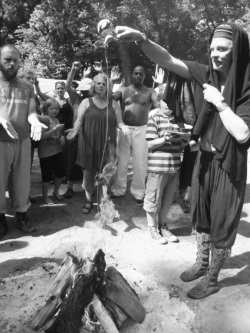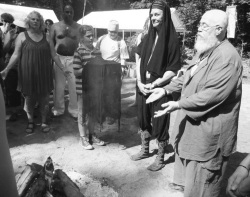The Morning Fire Offerings at PSG 2011by Steven Posch Originally in Spring 2012, pp. 54-55
The prototypes for the ritual are drawn from ancient (and modern) Baltic practice, influenced by Zoroastrian fire-offerings and the agnihotras of Hinduism. But the rite in some form was once present in nearly every Indo-European culture and, in a sense, in virtually every traditional culture in the world. How many billions of times in the course of human history has it happened? The woman of the house rises early in the morning, before anyone else, and wakes the fire that has slept banked through the night. She rakes away the protective bed of ash and adds fresh fuel. Onto the newly-wakened flames she sprinkles a few pinches of meal or flour by way of offering and, as she does so, prays for her family’s wellbeing. Then she starts to cook breakfast. This humble yet profound ritual, repeated daily in every household in practically every traditional culture, is the prototype for the larger, tribal fire-offerings of the Indo-European diaspora generally, and the fire-offerings of Vedic India and Zoroastrian Iran in particular. Lighting a sacred community fire to mark the ingathering of a group of people is standard practice among American First Nations, and has long been a sacred tradition at PSG. The fire is ceremoniously kindled at the beginning of the gathering, burns throughout the festival, and is ritually extinguished at its end. This fire is in effect the community hearth. It is fitting that offerings on the tribe’s behalf are made daily at the collective tribal hearth-fire. We made the Morning Fire Offering on each day of this year’s festival, when a handful of early arrivals gathered damply beneath the canopy that had protected the Fire from the previous night’s downpour. We were privileged to number among us that morning the handsome young fire-keeper who, his own tent flooded, had heroically kept all-night vigil to guard the Fire and keep it alight. On subsequent mornings, we made the offering immediately before Morning Meeting. By placing the ritual at this point in our shared day, I intended to help the PSG tribe begin in a sacred and prayerful way, and to highlight the sanctity of the Morning Meeting and the work that we do there together. Although technically the presence of the tribe is not required at the offering -- it is the priest’s responsibility to make the offerings and their accompanying prayers on the tribe’s behalf whether or not anyone else is present -- it became the custom for those who wished to participate more intimately in the offering to cluster around the fire. If there was a single lesson to be learned from the rituals of PSG, it was that as compressed molecules generate greater heat, so people clustered together generate greater power than they do in a vast one-deep circle. Each morning more and more people came to the fire, and I can testify from personal experience that the intensity of our collective prayer was so strong and so deep as to be (to speak for myself) at some points nearly overwhelming. As the triad goes: Three things give wing to prayer: the needful occasion, the offering, the soaring prayer of others. My thanks and appreciation to all those who participated in our Morning Fire Offerings. It was a pleasure and a privilege to serve you as, in effect, village priest; in all, the experience taught me many things about the nature and practice of priesthood. My special thanks to heart-friend and brother-in-rites Sparky T. Rabbit, who offered his usual insightful critique during the rite-crafting process. While retaining copyright and right of use, I hereby make a gift of this ritual to Pagan Spirit Gathering and the entire PSG community, from my hands to yours. It is my hope that you will receive this ritual and take it with you wherever you go, to use (or not) as you see fit. My one request is that if you do make use of this rite or some form of it, that you continue to credit me as its source. It’s a basic principle of human cultural endeavor that the single best way to encourage our creative people to generate more good material is to give them credit for the work that they’ve already done. My gratitude and ongoing prayers go with you all. Morning Fire Offering Ritual Fire Priest or Priestess: My brothers and sisters: we have it from the ancestors, and they from their ancestors, that the avenues of communication between ourselves and the Gods are most open during the making of offerings; so as I, by your leave (bows), make the morning offerings to the Fire, I would invite you to lift up your hands and to make your own prayers to whichever Gods your people make their prayers to. And so we begin. Priest covers head, and all rise. Blowing of horns. Priest uncovers offerings; People intone. First Offering (oil, ghee) is made; Priest prays for Life for the People. Second Offering (meal) is made; Priest prays for Food for the People. Third Offering (herbs, incense) is made; Priest prays for Beauty for the People. Priest re-covers offerings. All sing: Red Flower, Thunder Flower, Flower of the Sun, burn among us, burn within us, Flower of the Sun. Priest or Priestess: My brothers and sisters, our rite is ended, and let us all say: All: So mote it be. Blowing of horns. Priest uncovers head. [Lyrics: Steven Posch (based on a New Fire chant by Rosemary Sutcliff) © Steven W. Posch 2011, with special thanks to Bruner Soderberg] Morning Fire Offering Ritual Commentary
Introduction: When none of the people are present, or when a majority of those present are familiar with the Fire Offering, the introduction may be omitted. Priest covers head: It is long-standing tradition for the offerer to cover his (or her) head. This serves both to set him apart visually and to depersonalize him, and thus to keep collective focus where it should be: on the act of offering rather than on the offerer. Horn: Blowing horn(s) at the beginning of the ritual calls the attention of those present and within hearing distance (including the Gods themselves) to the offering that is about to take place. It represents Primal Sound and inaugurates the beginning of sacred time. Priest uncovers offerings: It is customary to bear the offerings on a cloth-covered tray. The practical reason is to protect the offerings, especially when performed outdoors; there are of course mystical meanings as well. People intone: When the people are present at the offering, it is customary for them to hum, drone, or intone during the making of the offerings. This continues until the offering tray is re-covered. First Offering (oil, ghee): The First Offering causes the Fire to flame up and be seen in all its beauty and power. The priest prays for Life for the People. Note: it is customary to make each Offering in three portions. Priest prays for Life (Food, Beauty) for the people: The prayers are best recited aloud but in an undertone. It should be apparent that the priest is praying, but it is not necessary for them to hear what he says. These are known in Latin tradition as the secreta: not "secret," but "separated" or "set apart" prayers. One paradox of priesthood is that the priest best serves the community by being set apart both in person and in prayer from others, at least for the duration of any given ritual. While others may pray for their own needs during this rite, the priest is not at liberty to do so: his job is to pray for the collective well-being. While formulas exist for the "secret" prayers, it is best for each officiant to formulate his own. Here as elsewhere in ritual, simple is best. Second Offering (meal): Cornmeal or any sort of flour is appropriate. The priest prays for Food for the People. Third Offering (herbs, incense): The Third Offering should be something that burns fragrantly. The priest prays for Beauty for the People. Hymn (all): A hymn to Fire or some other tribal God is appropriate. Horn: The second blowing of the horn(s) signifies the conclusion of the rite, informs those present and those within hearing distance that the offering has been duly made, and joins the rite’s end to its beginning. Priest uncovers his head: Having completed the offering, the priest’s commission to act singly on the people’s collective behalf comes to an end, and he reverts to his normal status as one of the people. |

 At the heart of all human culture burns Fire, both hero and trickster, revered in many traditions as a God in his or her own right. To honor this divine being -- the God who paradoxically dwells in every human home -- I crafted the Rite of Morning Fire Offering for the 2011 Pagan Spirit Gathering at Stonehouse Park in Illinois.
At the heart of all human culture burns Fire, both hero and trickster, revered in many traditions as a God in his or her own right. To honor this divine being -- the God who paradoxically dwells in every human home -- I crafted the Rite of Morning Fire Offering for the 2011 Pagan Spirit Gathering at Stonehouse Park in Illinois. The rite is intended to be performed daily at the tribal sanctuary's hearth fire. By custom, the priest should make the offering with head covered, and for all capable to stand for the duration of the rite. It is desirable for the people to be present; it is the priest’s obligation to make the offering regardless. In a domestic context, the same offerings would be made daily at the household hearth on the family’s behalf. In fact, the domestic offering -- traditionally made at the morning kindling of the Fire -- is the historic pattern for the larger, tribal rite. My use of male generics throughout should not be construed to mean that the performance of this rite is in any way restricted to men.
The rite is intended to be performed daily at the tribal sanctuary's hearth fire. By custom, the priest should make the offering with head covered, and for all capable to stand for the duration of the rite. It is desirable for the people to be present; it is the priest’s obligation to make the offering regardless. In a domestic context, the same offerings would be made daily at the household hearth on the family’s behalf. In fact, the domestic offering -- traditionally made at the morning kindling of the Fire -- is the historic pattern for the larger, tribal rite. My use of male generics throughout should not be construed to mean that the performance of this rite is in any way restricted to men.